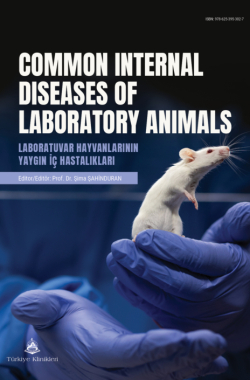Leptospirosis in Laboratory Animals
A. Cihat TUNÇa , Fatih M. BİRDANEa
aAfyon Kocatepe University Faculty of Veterinary Medicine, Department of Internal Medicine, Afyonkarahisar, Türkiye
Tunç AC, Birdane FM. Leptospirosis in laboratory animals. In: Şahinduran Ş, ed. Common Internal Diseases of Laboratory Animals. 1st ed. Ankara: Türkiye Klinikleri; 2024. p.42-5.
ABSTRACT
Leptospirosis is an important zoonotic disease caused by Leptospira which can pose significant risks to both animal and human health worldwide. Leptospira can usually be found in kidney and urinary tract. Accordingly, the spread of the disease generally occurs through infected animals’ urine. The agent is especially prevalent in humid regions, hot climates, and places with lots of waterlogging. Many Leptospirosis-related studies have been conducted in laboratory/experimental animals. Hamsters are widely used in Leptospirosis studies. However, genetically modified mice and rats are also included in animal experiments. Studies conducted with Leptospirosis in laboratory animals provided the effects and treatments of Leptospira with different pathogenic properties and the development of vaccines against leptospirosis.
Keywords: Mice; jaundice; hemoglobinuria; Weil disease
Kaynak Göster
Referanslar
- Jin X, Zhang W, Ding Z, Wang H, Wu D, Xie X, et al. Efficacy of the Rabbit Polyclonal Anti-leptospira Antibody against Homotype or Heterotype Leptospira Infection in Hamster. PLoS Negl Trop Dis. 2016;10(12):e0005191. [Crossref] [PubMed] [PMC]
- Bharti AR, Nally JE, Ricaldi JN, Matthias MA, Diaz MM, Lovett MA, et al; Peru-United States Leptospirosis Consortium. Leptospirosis: a zoonotic disease of global importance. Lancet Infect Dis. 2003;3(12):757-71. [Crossref] [PubMed]
- Suepaul SM, Carrington CV, Campbell M, Borde G, Adesiyun AA. Seroepidemiology of leptospirosis in dogs and rats in Trinidad. Trop Biomed. 2014; 31(4):853-61.
- Levett PN. Leptospirosis. Clin Microbiol Rev. 2001;14(2):296-326. [Crossref] [PubMed] [PMC]
- Quinn PJ, Markey BK, Leonard FC, Fitz Patrick ES, Fanning S. Concise review of veterinary microbiology. 2nd ed. Chichester: John Wiley & Sons Ltd; 2016. p. 82-6.
- Songer JG, Post KW. Anğ Ö, Özgür NY, çevirmenler. Veteriner Hekimlik Mikrobiyolojisi: Hayvan Hastalığı Etkeni Olan Bakteriler ve Mantarlar. 1.Baskı. İstanbul: Nobel Tıp Kitabevleri; 2012. p.244-50.
- Brenner DJ, Kaufmann AF, Sulzer KR, Steigerwalt AG, Rogers FC, Weyant RS. Further determination of DNA relatedness between serogroups and serovars in the family Leptospiraceae with a proposal for Leptospira alexanderi sp. nov. and four new Leptospira genomospecies. Int J Syst Bacteriol. 1999;49 Pt 2:839-58. [Crossref] [PubMed]
- Brown CA, Roberts AW, Miller MA, Davis DA, Brown SA, Bolin CA, Jarecki-Black J, Greene CE, Miller-Liebl D. Leptospira interrogans serovar grippotyphosa infection in dogs. J Am Vet Med Assoc. 1996;209(7):1265-7. [Crossref] [PubMed]
- Zuerner RL, Bolin CA. Differentiation of Leptospira interrogans isolates by IS1500 hybridization and PCR assays. J Clin Microbiol. 1997;35(10):2612-7. [Crossref] [PubMed] [PMC]
- Gomes-Solecki M, Santecchia I, Werts C. Animal Models of Leptospirosis: Of Mice and Hamsters. Front Immunol. 2017;8:58. [Crossref] [PubMed] [PMC]
- Inada R, Ido Y, Hoki R, Kaneko R, Ito H. The Etiology, Mode Of Infection, And Specific Therapy Of Weil's Disease (Spirochaetosis Icterohaemorrhagica). J Exp Med. 1916;23(3):377-402. [Crossref] [PubMed] [PMC]
- Morton HE. Susceptibility of Syrian hamsters to leptospirosis. Proc Soc Exp Biol Med. 1942;49:566-8. [Crossref]
- Imamura S, Ashizawa Y, Nagata Y. Studies on leptospirosis. I. Experimental leptospirosis of mice with jaundice, hemorrhage and high mortality. Jpn J Exp Med. 1960;30:427-31.
- Kobayashi Y. Clinical observation and treatment of leptospirosis. J Infect Chemother. 2001;7(2):59-68. [Crossref] [PubMed]
- Fujita R, Koizumi N, Sugiyama H, Tomizawa R, Sato R, Ohnishi M. Comparison of Bacterial Burden and Cytokine Gene Expression in Golden Hamsters in Early Phase of Infection with Two Different Strains of Leptospira interrogans. PLoS One. 2015;10(7):e0132694. [Crossref] [PubMed] [PMC]
- Muslich LT, Villanueva SY, Amran MY, Segawa T, Saito M, Yoshida S. Characterization of Leptospira infection in suckling and weaning rat pups. Comp Immunol Microbiol Infect Dis. 2015;38:47-55. [Crossref] [PubMed]
- Nally JE, Chantranuwat C, Wu XY, Fishbein MC, Pereira MM, Da Silva JJ, et al. Alveolar septal deposition of immunoglobulin and complement parallels pulmonary hemorrhage in a guinea pig model of severe pulmonary leptospirosis. Am J Pathol. 2004;164(3):1115-27. [Crossref] [PubMed]
- Pereira MM, Andrade J, Marchevsky RS, Ribeiro dos Santos R. Morphological characterization of lung and kidney lesions in C3H/HeJ mice infected with Leptospira interrogans serovar icterohaemorrhagiae: defect of CD4+ and CD8+ T-cells are prognosticators of the disease progression. Exp Toxicol Pathol. 1998;50(3):191-8. [Crossref] [PubMed]
- Hu W, Lin X, Yan J. Leptospira and leptospirosis in China. Curr Opin Infect Dis. 2014;27(5):432-6. [Crossref] [PubMed]
- Pappas G, Cascio A. Optimal treatment of leptospirosis: queries and projections. Int J Antimicrob Agents. 2006;28(6):491-6. [Crossref] [PubMed]
- Jost BH, Adler B, Vinh T, Faine S. A monoclonal antibody reacting with a determinant on leptospiral lipopolysaccharide protects guinea pigs against leptospirosis. J Med Microbiol. 1986;22(3):269-75. [Crossref] [PubMed]
- Masuzawa T, Suzuki R, Yanagihara Y. Protective activity of rabbit polyclonal anti-idiotype antibody against Leptospira interrogans infection in hamsters. Biol Pharm Bull. 1996;19(4):613-5. [Crossref] [PubMed]

